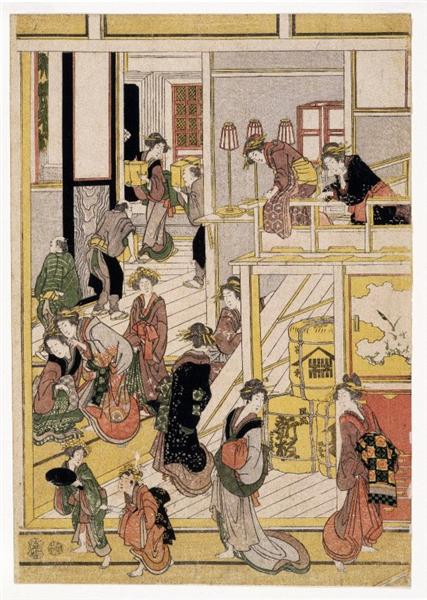Beskrivelse
Katsushika Hokusai's "New Year's Days at the Ogi-Ya Teahouse" (1812) is one of the most evocative pieces in the series of ukiyo-e prints that capture the essence of everyday life in Edo-era Japan. Illustrating a New Year's celebration in an elegant teahouse, this painting not only reflects Hokusai's technical mastery but also his keen insight into the nuances of social life in his time.
In the foreground is a richly detailed composition depicting a group of figures in a festive setting. The women and men, dressed in elaborate, vibrantly colored kimonos, interact with one another, creating a sense of community and celebration. Hokusai captures a variety of postures and gestures that reflect the joy and merriment of this holiday. The attention to textile detail in the kimonos is remarkable, reflecting both ingenuity in design and the artist's technical skill in the depiction of pattern and color.
The use of colour in this painting is vibrant and dynamic. Hokusai employs a palette that combines warm and cool tones, creating a contrast that enhances the liveliness of the scene. Deep blues and greens interact harmoniously with vivid reds, yellows and golds, evoking the visual richness that characterises Japanese culture. This colour choice not only serves to highlight the clothing and adornments, but also contributes to the sense of festivity and joy that emanates from the work. The background, with its stylised mountain landscape, evokes a connection with nature, a recurring theme in Hokusai’s work, who sought to balance the representation of humans with the natural environment.
In addition to the visual aspects, the work presents a narrative that goes beyond the mere depiction of a holiday. The expressions on the characters’ faces, though stylized, communicate a sense of camaraderie and shared joy, encapsulating the spirit of the New Year as a time of renewal and hope. The work can be seen as a commentary on social relationships, tradition, and the passage of time, a central theme in many of Hokusai’s works.
Known for his wit and ability to innovate within the ukiyo-e form, Hokusai also experimented with perspective and visual narrative. In “New Year’s Days at the Ogi-Ya Teahouse,” we can see how he uses the arrangement of characters and objects to guide the viewer’s eye through the scene. This dynamic approach not only invites close exploration of each element, but also suggests a flow of time and activity—a hallmark of his style.
In a broader context, this work is situated within the tradition of ukiyo-e that flourished during the Edo period, a time when urban life and teahouse culture became a symbol of refinement and sophistication. Hokusai, with his ability to capture the essence of these ephemeral moments, became one of the most important exponents of this genre, influencing generations of artists both in Japan and the West.
Thus, “New Year’s Days at the Ogi-Ya Teahouse” is not only a festive depiction of a cultural tradition, but is also an exploration of the interconnection between human beings and their environment, a work that continues to resonate with modernity and relevance in the present. Hokusai’s mastery lies in his ability to capture the essence of human existence in such a rich and complex way, which makes each work unique within the vast tradition of Japanese art.
KUADROS ©, a famous painting on your wall.
Hand-made oil painting reproductions, with the quality of professional artists and the distinctive seal of KUADROS ©.
Painting reproduction service with satisfaction guarantee. If you are not completely satisfied with the replica of your painting, we will refund 100% of your money.

